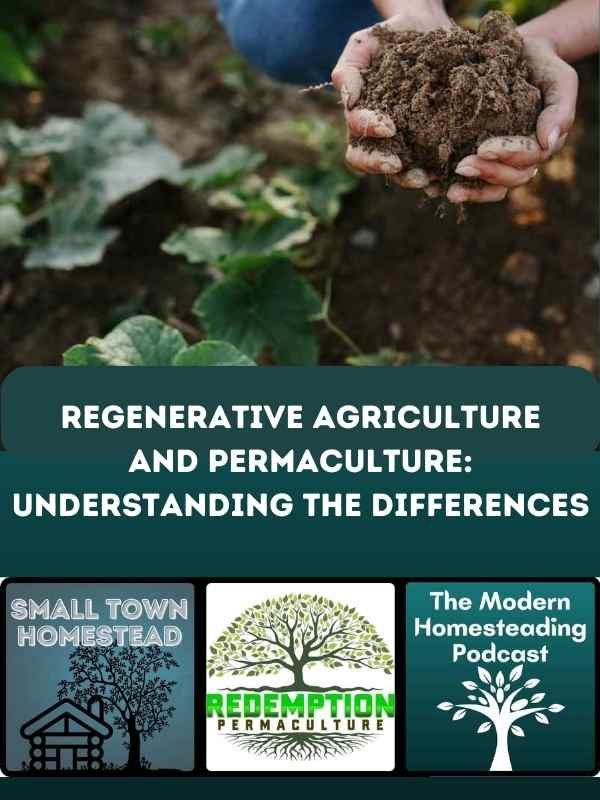The discussion about sustainable farming practices often highlights two significant approaches: Regenerative Agriculture and Permaculture. While they share common goals of sustainability and ecological stewardship, these methodologies do have some overlap but differ slightly in principles, practices, and execution. Let’s delve into the differences by providing an understanding of both approaches.

Introduction to Sustainable Farming Practices
Sustainable farming practices are more crucial than ever in today’s world, where environmental challenges and food security are major concerns. Both Regenerative Agriculture and Permaculture fall under this umbrella and are both worthy of practice, but they do have some distinct methodologies and objectives.
Understanding Regenerative Agriculture
Definition and Principles Regenerative Agriculture is a holistic land management practice that seeks to restore and enhance the health of ecosystems. It focuses on soil health, water management, and biodiversity.
Some Key Practices
- No-till farming
- Cover cropping
- Rotational grazing
- Integrated pest management
Goals and Benefits The primary goal is to improve soil health, which in turn improves crop yield and crop quality, supports water conservation, and enhances biodiversity. It also aims to sequester carbon in the soil, reducing greenhouse gases.
Regenerative Agriculture can also be more profitable than conventional farming due to lower input costs and the ability to grow higher-value crops.
- Atthowe, Helen (Author)
- English (Publication Language)
- 384 Pages – 06/22/2023 (Publication Date) – Chelsea Green Publishing (Publisher)
Last update on 2025-07-10 / Affiliate links / Images from Amazon Product Advertising API
Exploring Permaculture
Definition and Principles Permaculture, short for “permanent agriculture,” is a design philosophy emphasizing sustainable and self-sufficient agricultural ecosystems. It’s rooted in three core tenets: care for the earth, care for people, and fair share. These tenets are carried out through 12 principles that offer guidance for those who want to implement permaculture
Some Key Practices
- Creating edible landscapes
- Emphasizing perennial plants and self-seeding annuals
- Implementing natural water harvesting systems
- Utilizing natural resources efficiently
Goals and Benefits Permaculture aims to create sustainable and self-sufficient ecosystems that provide for human needs while maintaining ecological balance. It focuses on reducing waste, maximizing resource use, and promoting diversity in ecosystems.
- Used Book in Good Condition
- Bane, Peter (Author)
- English (Publication Language)
Last update on 2025-07-11 / Affiliate links / Images from Amazon Product Advertising API
Comparing Regenerative Agriculture and Permaculture
Similarities Both practices aim at sustainable ecosystems and focus on holistic approaches to farming. They prioritize soil health, biodiversity, and sustainable resource use.
Differences
- Scope and Scale: Regenerative Agriculture can be more easily applied to large-scale farming, whereas Permaculture is more often used in smaller, homestead scale and community-based settings.
- Techniques and Implementation: Regenerative Agriculture is more focused on soil and land management, while Permaculture encompasses a broader design philosophy that includes social and economic aspects.
- End Goals: The end goal of Regenerative Agriculture is primarily ecological restoration, whereas Permaculture aims for self-sufficiency and sustainability in all aspects of living.
Implementing Regenerative Agriculture and Permaculture in Modern Farming
Challenges and Opportunities Both practices face challenges in widespread adoption, including economic barriers and a lack of awareness. However, the growing interest in sustainable practices presents opportunities for education and implementation on a larger scale.
Case Studies and Success Stories Illustrating successful implementations of these practices through case studies can provide valuable insights and encourage adoption.
Check Out These Examples of Sustainable Farming Practices
- Minimize Inputs With Ecological Soil and Habitat Building Systems: Guest Helen Atthowe
- Beautiful 1-Acre Small Scale Permaculture Property | Limestone Permaculture Farm Tour
The Future of Sustainable Farming
The future of sustainable farming likely involves a combination of various practices, including Regenerative Agriculture and Permaculture. As the world grapples with environmental challenges, these methodologies offer promising solutions for a sustainable and resilient agricultural system.
Conclusion
Regenerative Agriculture and Permaculture, while similar in their sustainable goals, differ slightly in their principles, practices, and applications. Understanding these methods is key to implementing the right approach for specific contexts and goals, contributing to a more sustainable and environmentally friendly future in agriculture.
My personal opinion is that regenerative agriculture has a more realistic opportunity to be applied in large-scale farming applications. Permaculture, on the other hand, can serve small farms, homesteads, and local communities in a better way as a more holistic approach to sustainability.
Resources
- ScienceDirect – Regenerative agriculture: the soil is the base – https://www.sciencedirect.com/science/article/pii/S2211912420300584
- Meeting global challenges with regenerative agriculture producing food and energy – https://www.nature.com/articles/s41893-021-00827-y
- Regenerative agriculture—agroecology without politics? – https://www.frontiersin.org/articles/10.3389/fsufs.2022.844261/full
- Regenerative Agriculture: An agronomic perspective – https://journals.sagepub.com/doi/full/10.1177/0030727021998063
- What Is Regenerative Agriculture? A Review of Scholar and Practitioner Definitions Based on Processes and Outcomes – https://www.frontiersin.org/articles/10.3389/fsufs.2020.577723/full?&utm_source=Em
- Farming for a better climate: five examples of regenerative farming practices – https://www.eitfood.eu/blog/farming-for-a-better-climate-five-examples-of-regenerative-farming-practices
- Soils For Life: Regenerative Agriculture Case Studies – https://soilsforlife.org.au/case-studies/






This article is perhaps an oversimplification of both agricultural practices in order to point out some differences. That being said which method do you practice or do you see as being a “better way” to meet the sustainability challenges we are facing? Leave a comment.